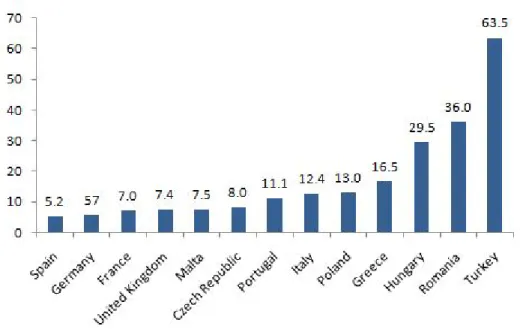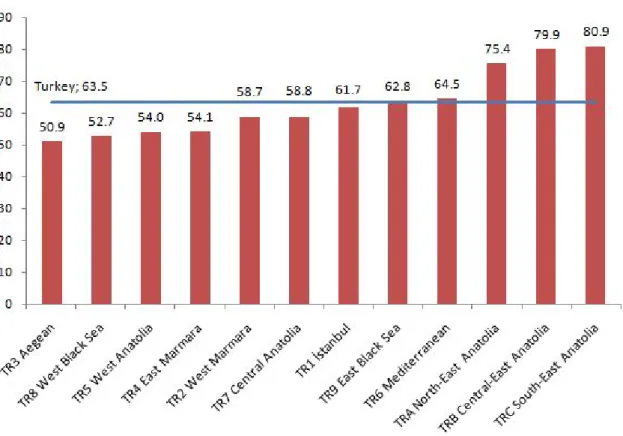TWO IN THREE CHILDREN LIVE IN SEVERE MATERIAL DEPRIVATION
Seyfettin Gürsel*, Gökçe Uysal and Melike KökkızılExecutive Summary
According to the European Union standards, two out of every three children in Turkey live in severe material deprivation. In terms of severe material deprivation among children, Turkey falls behind Southern Europe countries as well as countries that are less developed such as Hungary and Romania. Frequency of severe material deprivation falls to 50-55 percent in western regions in Turkey whereas it increases to 75 percent in its eastern regions. Such high shares make it difficult to pinpoint a high-priority target group for policy, hence, Betam has started using a narrower definition of basic material deprivation. According to the definition used by Betam, 24.8 percent of children in Turkey live in basic material deprivation. The share of children living in basic material deprivation falls substantially and rapidly from 2006 to 2010, however there is a small increase in 2011. Child poverty indicates dire circumstances for this as well as the upcoming generations and therefore, fight against to child poverty should move up the priority list among social policies.
What is severe material deprivation according to the definition of European Union?
Eurostat defines severe material as "a state of economic strain and durables, defined as the enforced inability (rather than the choice not to do so)" to satisfy certain needs. The measure used by Eurostat can be also calculated for Turkey by using Statistics on Income and Living Conditions. According to this measure, people who cannot afford at least four of the following items are severely materially deprived. (1) to pay their rent, mortgage or utility bills, (2) the keep their home adequately warm, (3) to face unexpected expenses, (4) to eat a meal involving meat, chicken or fish every second day, (5) to afford a one-week annual holiday away from home, (6) a washing machine, (7) color television, (8) telephone or (9) car.
Figure 1 shows various countries' severe material deprivation rates among the children aged between 0 and 15. It indicates that two out of every three children in Turkey are severely materially deprived according to the European standards. Another serious implication that data indicates is that the children in Turkey are living under worse conditions compared to their peers who live in other countries of Europe. The countries selected in our sample cover some of European Union countries have higher levels of development such as Germany, France, and United Kingdom as well as countries with lower levels of development such as Poland, Hungary, and Romania. Severe
**Prof. Dr. Seyfettin Gürsel, Betam, Director, seyfettin.gursel@bahcesehir.edu.tr
Asst. Prof. Gökçe Uysal, Betam, Vice Director, gokce.uysal@bahcesehir.edu.tr
Melike Kökkızıl, Betam, Research Assistant, melike.kokkizil@bahcesehir.edu.tr
22 April 2014
material deprivation rate among the children aged between 0 and 15 for Turkey was 63.5 percent in 2011, however for Romania, which has the closest rate to Turkey, the rate is 36 percent. The same rate for Greece is 16.5 percent whereas it falls to 12.4 percent for Italy.
Figure 1 Severe material deprivation rate among children aged under 16, 2011
Source: Eurostat ; Turkstat ; Betam
Three out of every four children in Eastern regions live in severe material deprivation
Data from Survey of Income and Living Conditions (SILC) conducted by the Turkish Statistical Institute (Turkstat) enables us to study the regional differences in material deprivation. There are significant regional disparities in Turkey in terms of severe material deprivation. Figure 2 indicates the share of severely materially deprived children among their peers by region. At first glance, the depth of differences between West - East stands out. Severe material deprivation rate among children was 50.9 percent in the Aegean region whereas the rate for South-East Anatolia is 80.9 percent. The regions of West Black Sea, West Anatolia and East Marmara are below of Turkey average. On the other hand, approximately three out of every four children are in severely materially deprived in the regions of North-East Anatolia, Central-East Anatolia, and South-East Anatolia.
Istanbul and Mediterranean regions are exceptions in the East- West segregation. The frequency of severe material deprivation among children is 61.7 percent in Istanbul and 64.5 percent in the Mediterranean region. High influxes of immigrants to these regions may be one of the factors that cause high rate of severe material deprivation. High cost of living in Istanbul is also a determinant. In the Mediterranean region, the wide income gap between its mountain and coastal areas may cause a high rate of severe material deprivation.
Figure 2 Severe material deprivation rate among children by region , 2011
Source: Turkstat, 2011 Income and Living Conditions Survey micro dataset; Betam
Can we use another measure for material deprivation?
Using the European Union definition for severe material deprivation allows us to make international comparisons. The relative status of the children in Turkey can be analyzed using such measures. However, for policymaking purposes, such high rates are impractical since researchers and policy makers need to pinpoint those children who are in immediate need of policies that will lift them out of poverty. Betam has developed and started using a new and experimental definition in order to measure basic material deprivation. This definition of basic material deprivation concentrates on three basic needs; to keep their home adequately warm, to eat meat, chicken or fish every other day, and to replace their old clothes with the new ones. People who cannot afford any of these three needs are defined to be in basic material deprivation.
Table 1 Basic material deprivation rates among children
2006 2007 2008 2009 2010 2011
Basic material deprivation 34.7 34.1 30.9 28.9 24.4 24.8
Nutrition 69.1 66.5 63.7 65.7 66.9 64.7
Heating 45.2 45.3 46.1 43.0 40.3 39.9
Clothing 60.2 55.5 49.4 48.0 40.8 40.0
Source: Turkstat, 2011 Income and Living Conditions Survey micro dataset; Betam
Table 1 indicates the rate of basic material deprivation among children in Turkey. According to these results calculated again by using Income and Living Conditions Survey dataset, 24.8 percent of the
children in Turkey in the year of 2011 cannot keep their home adequately warm , cannot eat meat, chicken or fish every other day and cannot replace their old clothes with the new ones. 1
The rates of children who cannot meet any of these three basic needs have substantially and rapidly declined from 2006 to 2010. According to the alternative measurement, basic material deprivation rate among children declined from 34.7 percent in 2006 to 24.4 percent in 2010. A decrease of 10 percentage points in four years is an impressive result. Nevertheless, there is a small increase in 2011 and the rate of basic material deprivation increases to 24.8 percent. The share of children who cannot meet their own protein needs has declined from 66.9 to 64.7 percent and the share of children cannot keep their homes warm has decreased from 40.3 to 39.9 percent, and the share of children who cannot meet their clothing needs has fallen from 40.8 to 40 percent between the years of 2010 and 2011. Nonetheless, the share of children who can afford neither of three basic needs increased, albeit slightly.
Both international comparisons and trends in Turkey clearly show that child poverty in Turkey is persistent and severe. Since the effects of child poverty are persistent, in fact, its detrimental effects can be long term in case of powerful intergenerational transmission mechanisms, designing and implementing urgent and active social policies in this subject is a must.
1 Since the age variable in the SILC micro dataset is provided in 5-year age groups until 2010, results for Turkey are calculated for the children between the year of 0 and 14 for this section. Data for 2011 allows us to compute the rates for both 0-14 and 0-15 age groups. The difference is merely 0.1 percentage points.

